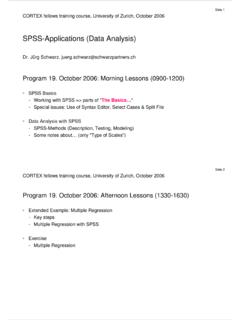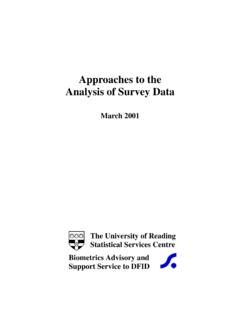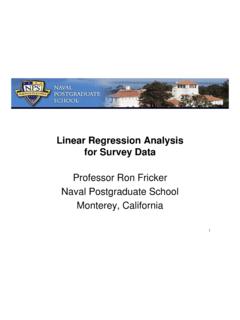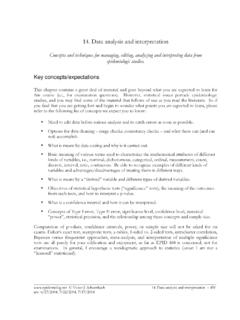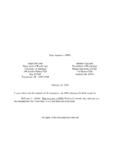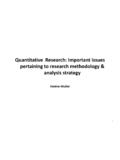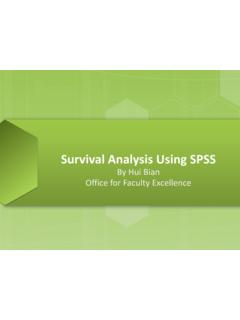Transcription of An Introduction to Logistic Regression Analysis and Reporting
1 ABSTRACTThe purpose of this article is to provideresearchers, editors, and readers with a set of guidelines forwhat to expect in an article using Logistic Regression tech-niques. Tables, figures, and charts that should be included tocomprehensively assess the results and assumptions to be ver-ified are discussed. This article demonstrates the preferredpattern for the application of Logistic methods with an illustra-tion of Logistic Regression applied to a data set in testing aresearch hypothesis. Recommendations are also offered forappropriate Reporting formats of Logistic Regression resultsand the minimum observation-to-predictor ratio.
2 The authorsevaluated the use and interpretation of Logistic Regression pre-sented in 8 articles published in The Journal of EducationalResearch between 1990 and 2000. They found that all 8 studiesmet or exceeded recommended words: binary data Analysis , categorical variables,dichotomous outcome, Logistic modeling, Logistic regressionany educational research problems call for theanalysis and prediction of a dichotomous outcome:whether a student will succeed in college, whether a childshould be classified as learning disabled (LD), whether ateenager is prone to engage in risky behaviors, and so , these research questions were addressed byeither ordinary least squares (OLS) Regression or linear dis-criminant function Analysis .
3 Both techniques were subse-quently found to be less than ideal for handling dichoto-mous outcomes due to their strict statistical assumptions, , linearity, normality, and continuity for OLS regressionand multivariate normality with equal variances and covari-ances for discriminant Analysis (Cabrera, 1994; Cleary &Angel, 1984; Cox & Snell, 1989; Efron, 1975; Lei &Koehly, 2000; Press & Wilson, 1978; Tabachnick & Fidell,2001, p. 521). Logistic Regression was proposed as an alter-native in the late 1960s and early 1970s (Cabrera, 1994),and it became routinely available in statistical packages inthe early that time, the use of Logistic Regression hasincreased in the social sciences ( , Chuang, 1997; Janik& Kravitz, 1994; Tolman & Weisz, 1995) and in education-al research especially in higher education (Austin, Yaffee,& Hinkle, 1992; Cabrera, 1994; Peng & So, 2002a; Peng,So, Stage, & St.)
4 John, 2002. With the wide availability ofsophisticated statistical software for high-speed computers,the use of Logistic Regression is increasing. This expandeduse demands that researchers, editors, and readers beattuned to what to expect in an article that uses logisticregression techniques. What tables, figures, or charts shouldbe included to comprehensibly assess the results? Whatassumptions should be verified? In this article, we addressthese questions with an illustration of Logistic regressionapplied to a data set in testing a research hypothesis.
5 Rec-ommendations are also offered for appropriate reportingformats of Logistic Regression results and the minimumobservation-to-predictor ratio. The remainder of this articleis divided into five sections: (1) Logistic Regression Mod-els, (2) Illustration of Logistic Regression Analysis andReporting, (3) Guidelines and Recommendations, (4) Eval-uations of Eight Articles Using Logistic Regression , and (5) Regression ModelsThe central mathematical concept that underlies logisticregression is the logit the natural logarithm of an oddsratio.
6 The simplest example of a logit derives from a 2 2contingency table. Consider an instance in which the distri-bution of a dichotomous outcome variable (a child from aninner city school who is recommended for remedial readingclasses) is paired with a dichotomous predictor variable(gender). Example data are included in Table 1. A test ofindependence using chi-square could be applied. The resultsyield 2(1) = Alternatively, one might prefer to assessAn Introduction to Logistic RegressionAnalysis and ReportingCHAO-YING JOANNE PENGKUK LIDA LEEGARY M.
7 INGERSOLLI ndiana University-BloomingtonAddress correspondence to Chao-Ying Joanne Peng, Depart-ment of Counseling and Educational Psychology, School of Edu-cation, Room 4050, 201 N. Rose Ave., Indiana University, Bloom-ington, IN 47405 1006. (E-mail: boy s odds of being recommended for remedial readinginstruction relative to a girl s odds. The result is an odds ratioof , which suggests that boys are times more like-ly, than not, to be recommended for remedial reading class-es compared with girls. The odds ratio is derived from twoodds (73/23 for boys and 15/11 for girls); its natural loga-rithm [ , ln( )] is a logit, which equals The valueof would be the Regression coefficient of the gender pre-dictor if Logistic Regression were used to model the two out-comes of a remedial recommendation as it relates to , Logistic Regression is well suited for describingand testing hypotheses about relationships between a cate-gorical outcome variable and one or more categorical or con-tinuous predictor variables.)
8 In the simplest case of linearregression for one continuous predictor X(a child s readingscore on a standardized test) and one dichotomous outcomevariable Y(the child being recommended for remedial read-ing classes), the plot of such data results in two parallel lines,each corresponding to a value of the dichotomous outcome(Figure 1). Because the two parallel lines are difficult to bedescribed with an ordinary least squares Regression equationdue to the dichotomy of outcomes, one may instead createcategories for the predictor and compute the mean of the out-come variable for the respective categories.
9 The resultant plotof categories means will appear linear in the middle, muchlike what one would expect to see on an ordinary scatter plot,but curved at the ends (Figure 1, the S-shaped curve). Such ashape, often referred to as sigmoidal or S-shaped, is difficultto describe with a linear equation for two reasons. First, theextremes do not follow a linear trend. Second, the errors areneither normally distributed nor constant across the entirerange of data (Peng, Manz, & Keck, 2001). Logistic regres-sion solves these problems by applying the logit transforma-tion to the dependent variable.
10 In essence, the Logistic modelpredicts the logit of Yfrom stated earlier, the logit is thenatural logarithm (ln) of odds of Y, and odds are ratios ofprobabilities ( ) of Yhappening ( , a student is recom-mended for remedial reading instruction) to probabilities (1 ) of Ynot happening ( , a student is not recommended forremedial reading instruction). Although Logistic regressioncan accommodate categorical outcomes that are polytomous,in this article we focus on dichotomous outcomes only. Theillustration presented in this article can be extended easily topolytomous variables with ordered ( , ordinal-scaled) orunordered ( , nominal-scaled) simple Logistic model has the form(1)For the data in Table 1, the Regression coefficient ( ) is thelogit ( ) previously explained.



